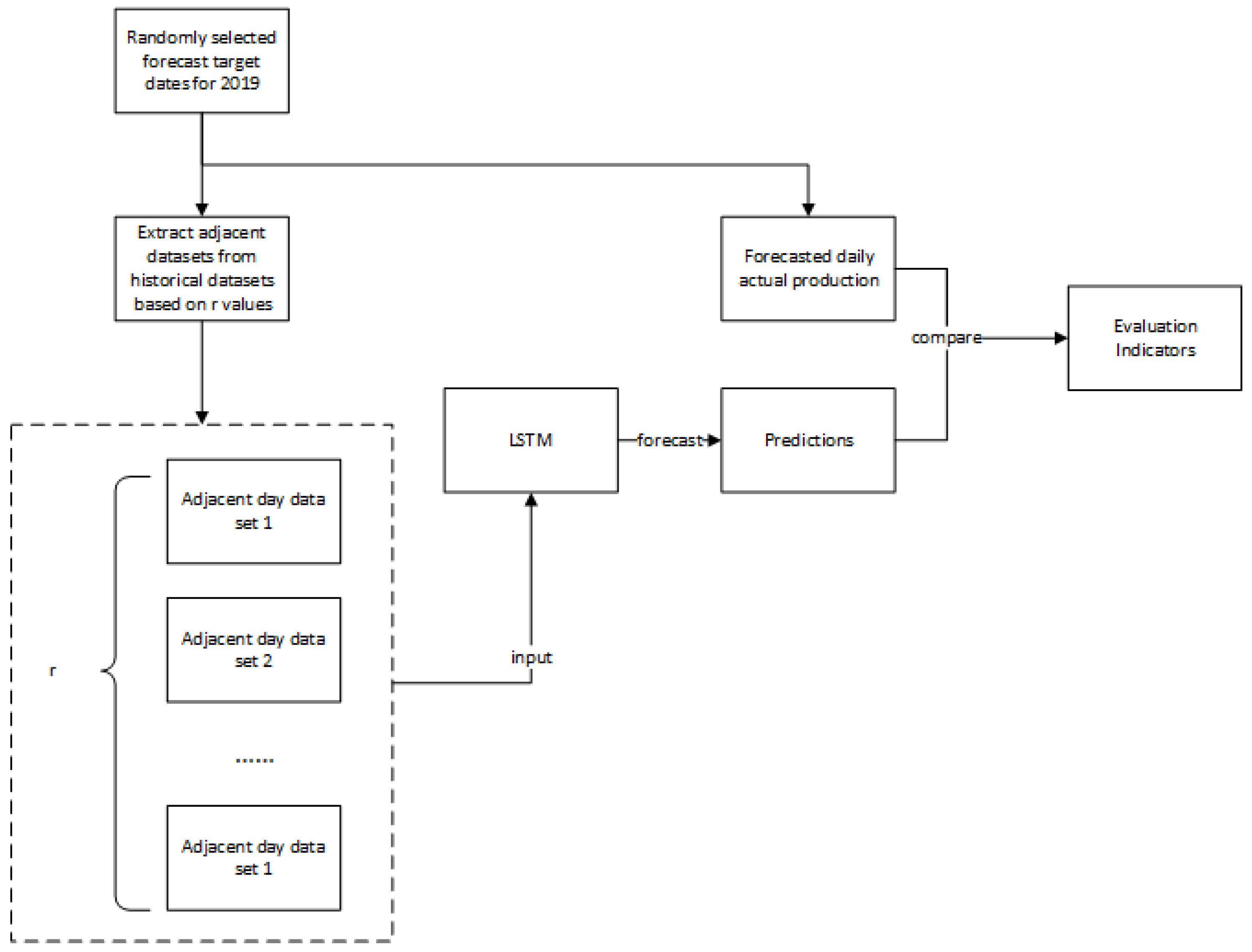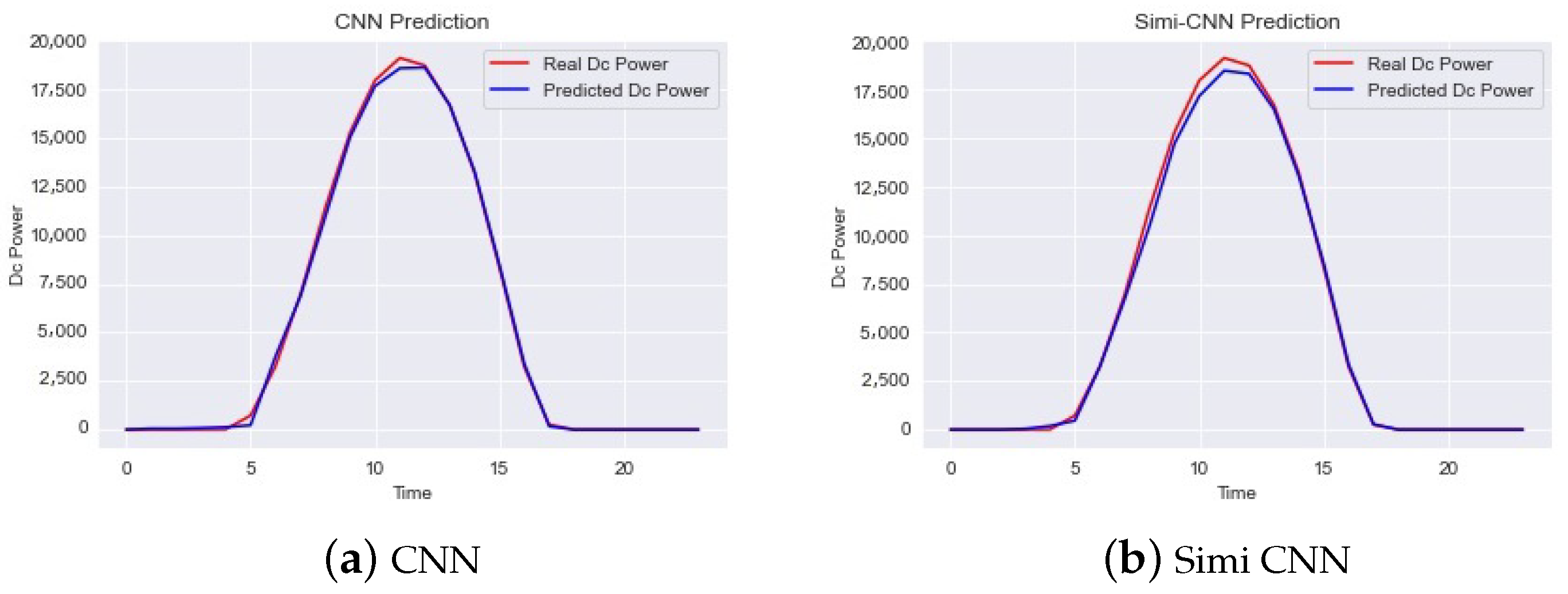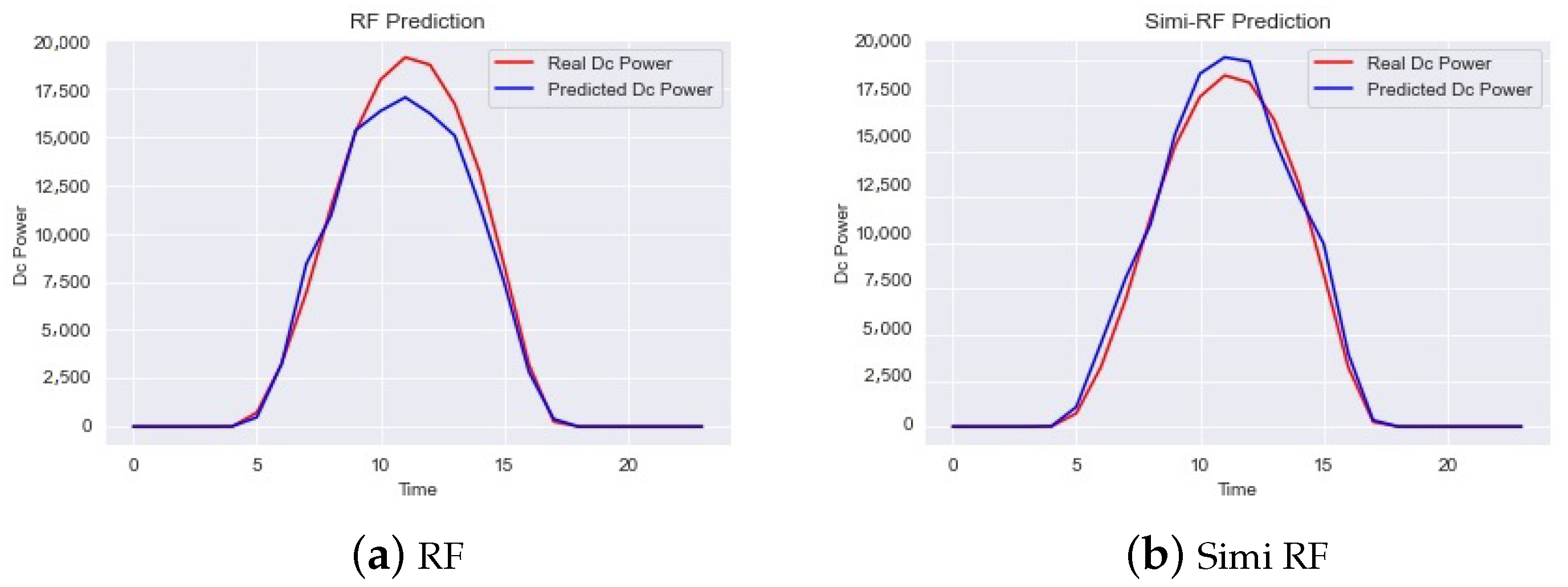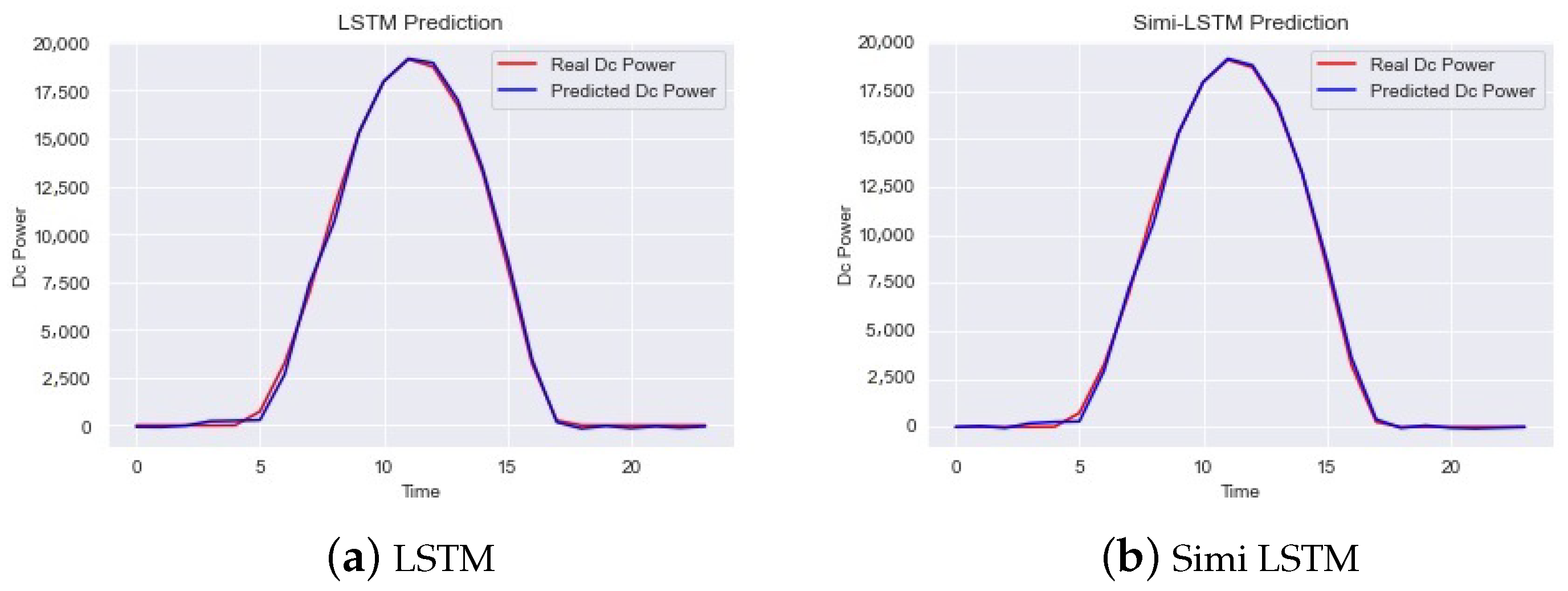An Improved Method for Photovoltaic Forecasting Model Training Based on Similarity
Abstract
1. Introduction
- The regularity of PV power generation is explored through data processing and experimental analysis, finding extremely high similarity in historical power generation data and determining the key influence of solar irradiance.
- Through experimental analysis of the number of neighboring days, the optimal number of neighboring days for PV power generation prediction is found. It is possible to achieve improved prediction accuracy compared to using the full dataset for training. In addition, the proposed approach is able to find the smallest possible dataset size for training.
- Based on the existing research, along with integrating the above experimental analysis results, it is demonstrated experimentally that the proposed method for improved PV power generation prediction has a significantly improved effect on training speed for deep learning, integration learning, etc., while keeping the prediction accuracy of PV power generation almost unchanged.
2. Related Works
3. Materials and Methods
3.1. Dataset Introduction
3.2. Photovoltaic Power Generation Analysis
3.3. Adjacent Day
- An increase in the number of adjacent days results in a significant improvement in the accuracy of PV generation forecasting.
- When the number of adjacent days is increased to seven days, the improvement in the accuracy of PV generation forecasting is very limited, with R2 and nRMSE values fluctuating around 0.992 and 11, respectively.
4. Experimental Evaluation
- The expanded adjacent days model is effective in reducing the size of the dataset when performing PV generation forecasting, and the integrated learning method effectively reduces the training time for random forest models.
- The improved model using expanded adjacent days is able to maintains a high level of accuracy in PV power prediction.
5. Conclusions
Author Contributions
Funding
Data Availability Statement
Acknowledgments
Conflicts of Interest
References
- Kumari, P.; Toshniwal, D. Impact of lockdown on air quality over major cities across the globe during COVID-19 pandemic. Urban Clim. 2020, 34, 100719. [Google Scholar] [CrossRef]
- Espinar, B.; Aznarte, J.L.; Girard, R.; Moussa, A.M.; Kariniotakis, G. Photovoltaic Forecasting: A state of the art. In Proceedings of the 5th European PV-Hybrid and Mini-Grid Conference, Tarragona, Spain, 29–30 April 2010; OTTI-Ostbayerisches Technologie-Transfer-Institut: Regensburg, Germany, 2010; p. 250. [Google Scholar]
- Shi, H.; Xu, M.; Li, R. Deep learning for household load forecasting—A novel pooling deep RNN. IEEE Trans. Smart Grid 2017, 9, 5271–5280. [Google Scholar] [CrossRef]
- Kong, X.; Li, C.; Zheng, F.; Wang, C. Improved deep belief network for short-term load forecasting considering demand-side management. IEEE Trans. Power Syst. 2019, 35, 1531–1538. [Google Scholar] [CrossRef]
- Abuella, M.; Chowdhury, B. Solar power forecasting using artificial neural networks. In Proceedings of the 2015 North American Power Symposium (NAPS), Charlotte, NC, USA, 4–6 October 2015; IEEE: Piscataway, NJ, USA, 2015; pp. 1–5. [Google Scholar]
- Chen, C.; Duan, S.; Cai, T.; Liu, B. Online 24-h solar power forecasting based on weather type classification using artificial neural network. Sol. Energy 2011, 85, 2856–2870. [Google Scholar] [CrossRef]
- Almonacid, F.; Pérez-Higueras, P.; Fernández, E.F.; Hontoria, L. A methodology based on dynamic artificial neural network for short-term forecasting of the power output of a PV generator. Energy Convers. Manag. 2014, 85, 389–398. [Google Scholar] [CrossRef]
- Vaz, A.; Elsinga, B.; Van Sark, W.; Brito, M. An artificial neural network to assess the impact of neighbouring photovoltaic systems in power forecasting in Utrecht, the Netherlands. Renew. Energy 2016, 85, 631–641. [Google Scholar] [CrossRef]
- Sfetsos, A.; Coonick, A. Univariate and multivariate forecasting of hourly solar radiation with artificial intelligence techniques. Sol. Energy 2000, 68, 169–178. [Google Scholar] [CrossRef]
- Yona, A.; Senjyu, T.; Saber, A.Y.; Funabashi, T.; Sekine, H.; Kim, C. Application of neural network to one-day-ahead 24 h generating power forecasting for photovoltaic system, Intelligent Systems Applications to Power Systems. In Proceedings of the IEEE International Conference on Intelligent Systems Applications to Power Systems, Kaohsiung, Taiwan, 5–8 November 2007; pp. 1–6. [Google Scholar]
- Breinl, K.; Turkington, T.; Stowasser, M. Simulating daily precipitation and temperature: A weather generation framework for assessing hydrometeorological hazards. Meteorol. Appl. 2015, 22, 334–347. [Google Scholar] [CrossRef]
- Liu, B.; Nowotarski, J.; Hong, T.; Weron, R. Probabilistic load forecasting via quantile regression averaging on sister forecasts. IEEE Trans. Smart Grid 2015, 8, 730–737. [Google Scholar] [CrossRef]
- Liu, J.; Huang, X.; Li, Q.; Chen, Z.; Liu, G.; Tai, Y. Hourly stepwise forecasting for solar irradiance using integrated hybrid models CNN-LSTM-MLP combined with error correction and VMD. Energy Convers. Manag. 2023, 280, 116804. [Google Scholar] [CrossRef]
- Chang, Z.; Zhang, Y.; Chen, W. Electricity price prediction based on hybrid model of adam optimized LSTM neural network and wavelet transform. Energy 2019, 187, 115804. [Google Scholar] [CrossRef]
- Alizamir, M.; Shiri, J.; Fard, A.F.; Kim, S.; Gorgij, A.D.; Heddam, S.; Singh, V.P. Improving the accuracy of daily solar radiation prediction by climatic data using an efficient hybrid deep learning model: Long short-term memory (LSTM) network coupled with wavelet transform. Eng. Appl. Artif. Intell. 2023, 123, 106199. [Google Scholar] [CrossRef]
- Ghimire, S.; Deo, R.C.; Casillas-Pérez, D.; Salcedo-Sanz, S.; Sharma, E.; Ali, M. Deep learning CNN-LSTM-MLP hybrid fusion model for feature optimizations and daily solar radiation prediction. Measurement 2022, 202, 111759. [Google Scholar] [CrossRef]
- Jaihuni, M.; Basak, J.K.; Khan, F.; Okyere, F.G.; Sihalath, T.; Bhujel, A.; Park, J.; Lee, D.H.; Kim, H.T. A novel recurrent neural network approach in forecasting short term solar irradiance. ISA Trans. 2022, 121, 63–74. [Google Scholar] [CrossRef] [PubMed]
- Pazikadin, A.R.; Rifai, D.; Ali, K.; Malik, M.Z.; Abdalla, A.N.; Faraj, M.A. Solar irradiance measurement instrumentation and power solar generation forecasting based on Artificial Neural Networks (ANN): A review of five years research trend. Sci. Total Environ. 2020, 715, 136848. [Google Scholar] [CrossRef] [PubMed]
- Paulescu, M.; Brabec, M.; Boata, R.; Badescu, V. Structured, physically inspired (gray box) models versus black box modeling for forecasting the output power of photovoltaic plants. Energy 2017, 121, 792–802. [Google Scholar] [CrossRef]
- Sharadga, H.; Hajimirza, S.; Balog, R.S. Time series forecasting of solar power generation for large-scale photovoltaic plants. Renew. Energy 2020, 150, 797–807. [Google Scholar] [CrossRef]
- Gao, M.; Li, J.; Hong, F.; Long, D. Day-ahead power forecasting in a large-scale photovoltaic plant based on weather classification using LSTM. Energy 2019, 187, 115838. [Google Scholar] [CrossRef]
- Li, B.; Feng, C.; Siebenschuh, C.; Zhang, R.; Spyrou, E.; Krishnan, V.; Hobbs, B.F.; Zhang, J. Sizing ramping reserve using probabilistic solar forecasts: A data-driven method. Appl. Energy 2022, 313, 118812. [Google Scholar] [CrossRef]
- Sun, M.; Feng, C.; Zhang, J. Probabilistic solar power forecasting based on weather scenario generation. Appl. Energy 2020, 266, 114823. [Google Scholar] [CrossRef]
- Hoyos-Gómez, L.S.; Ruiz-Muñoz, J.F.; Ruiz-Mendoza, B.J. Short-term forecasting of global solar irradiance in tropical environments with incomplete data. Appl. Energy 2022, 307, 118192. [Google Scholar] [CrossRef]
- Li, Q.; Xu, Y.; Chew, B.S.H.; Ding, H.; Zhao, G. An integrated missing-data tolerant model for probabilistic PV power generation forecasting. IEEE Trans. Power Syst. 2022, 37, 4447–4459. [Google Scholar] [CrossRef]
- Wen, H.; Du, Y.; Lim, E.G.; Wen, H.; Yan, K.; Li, X.; Jiang, L. A solar forecasting framework based on federated learning and distributed computing. Build. Environ. 2022, 225, 109556. [Google Scholar] [CrossRef]
- Wang, H.; Cai, R.; Zhou, B.; Aziz, S.; Qin, B.; Voropai, N.; Gan, L.; Barakhtenko, E. Solar irradiance forecasting based on direct explainable neural network. Energy Convers. Manag. 2020, 226, 113487. [Google Scholar] [CrossRef]
- Huang, X.; Li, Q.; Tai, Y.; Chen, Z.; Zhang, J.; Shi, J.; Gao, B.; Liu, W. Hybrid deep neural model for hourly solar irradiance forecasting. Renew. Energy 2021, 171, 1041–1060. [Google Scholar] [CrossRef]
- Nourani, V.; Behfar, N. Multi-station runoff-sediment modeling using seasonal LSTM models. J. Hydrol. 2021, 601, 126672. [Google Scholar] [CrossRef]
- Abdel-Nasser, M.; Mahmoud, K.; Lehtonen, M. Reliable solar irradiance forecasting approach based on choquet integral and deep LSTMs. IEEE Trans. Ind. Inform. 2020, 17, 1873–1881. [Google Scholar] [CrossRef]
- Fouilloy, A.; Voyant, C.; Notton, G.; Motte, F.; Paoli, C.; Nivet, M.L.; Guillot, E.; Duchaud, J.L. Solar irradiation prediction with machine learning: Forecasting models selection method depending on weather variability. Energy 2018, 165, 620–629. [Google Scholar] [CrossRef]
- Michael, N.E.; Hasan, S.; Al-Durra, A.; Mishra, M. Short-term solar irradiance forecasting based on a novel Bayesian optimized deep Long Short-Term Memory neural network. Appl. Energy 2022, 324, 119727. [Google Scholar] [CrossRef]
- Lan, H.; Zhang, C.; Hong, Y.Y.; He, Y.; Wen, S. Day-ahead spatiotemporal solar irradiation forecasting using frequency-based hybrid principal component analysis and neural network. Appl. Energy 2019, 247, 389–402. [Google Scholar] [CrossRef]
- Prasad, R.; Ali, M.; Kwan, P.; Khan, H. Designing a multi-stage multivariate empirical mode decomposition coupled with ant colony optimization and random forest model to forecast monthly solar radiation. Appl. Energy 2019, 236, 778–792. [Google Scholar] [CrossRef]
- Kwon, Y.; Kwasinski, A.; Kwasinski, A. Solar irradiance forecast using naïve Bayes classifier based on publicly available weather forecasting variables. Energies 2019, 12, 1529. [Google Scholar] [CrossRef]
- Kushwaha, V.; Pindoriya, N.M. A SARIMA-RVFL hybrid model assisted by wavelet decomposition for very short-term solar PV power generation forecast. Renew. Energy 2019, 140, 124–139. [Google Scholar] [CrossRef]
- Qing, X.; Niu, Y. Hourly day-ahead solar irradiance prediction using weather forecasts by LSTM. Energy 2018, 148, 461–468. [Google Scholar] [CrossRef]
- Antonanzas-Torres, F.; Urraca, R.; Polo, J.; Perpiñán-Lamigueiro, O.; Escobar, R. Clear sky solar irradiance models: A review of seventy models. Renew. Sustain. Energy Rev. 2019, 107, 374–387. [Google Scholar] [CrossRef]
- Kumari, P.; Toshniwal, D. Long short term memory–convolutional neural network based deep hybrid approach for solar irradiance forecasting. Appl. Energy 2021, 295, 117061. [Google Scholar] [CrossRef]
- Lin, Y.; Koprinska, I.; Rana, M.; Troncoso, A. Pattern sequence neural network for solar power forecasting. In Proceedings of the Neural Information Processing: 26th International Conference, ICONIP 2019, Sydney, NSW, Australia, 12–15 December 2019; Proceedings, Part V 26. Springer: Berlin/Heidelberg, Germany, 2019; pp. 727–737. [Google Scholar]
- Jeon, H.J.; Choi, M.W.; Lee, O.J. Day-Ahead Hourly Solar Irradiance Forecasting Based on Multi-Attributed Spatio-Temporal Graph Convolutional Network. Sensors 2022, 22, 7179. [Google Scholar] [CrossRef]
- Iraklis, C.; Smend, J.; Almarzooqi, A.; Mnatsakanyan, A. Flexibility forecast and resource composition methodology for virtual power plants. In Proceedings of the 2021 International Conference on Electrical, Computer and Energy Technologies (ICECET), Cape Town, South Africa, 9–10 December 2021; IEEE: Piscataway, NJ, USA, 2021; pp. 1–7. [Google Scholar]
- Bandara, K.; Bergmeir, C.; Hewamalage, H. LSTM-MSNet: Leveraging forecasts on sets of related time series with multiple seasonal patterns. IEEE Trans. Neural Netw. Learn. Syst. 2020, 32, 1586–1599. [Google Scholar] [CrossRef]
- Ghimire, S.; Deo, R.C.; Raj, N.; Mi, J. Deep solar radiation forecasting with convolutional neural network and long short-term memory network algorithms. Appl. Energy 2019, 253, 113541. [Google Scholar] [CrossRef]
- Kong, X.; Du, X.; Xu, Z.; Xue, G. Predicting solar radiation for space heating with thermal storage system based on temporal convolutional network-attention model. Appl. Therm. Eng. 2023, 219, 119574. [Google Scholar] [CrossRef]
- Shi, J.; Lee, W.J.; Liu, Y.; Yang, Y.; Wang, P. Forecasting power output of photovoltaic systems based on weather classification and support vector machines. IEEE Trans. Ind. Appl. 2012, 48, 1064–1069. [Google Scholar] [CrossRef]
- Jiang, H.; Hong, L. Application of BP neural network to short-term-ahead generating power forecasting for PV system. Adv. Mater. Res. 2013, 608, 128–131. [Google Scholar] [CrossRef]
- Mellit, A.; Sağlam, S.; Kalogirou, S.A. Artificial neural network-based model for estimating the produced power of a photovoltaic module. Renew. Energy 2013, 60, 71–78. [Google Scholar] [CrossRef]
- Ahmad, T.; Huanxin, C.; Zhang, D.; Zhang, H. Smart energy forecasting strategy with four machine learning models for climate-sensitive and non-climate sensitive conditions. Energy 2020, 198, 117283. [Google Scholar] [CrossRef]
- Boilley, A.; Thomas, C.; Marchand, M.; Wey, E.; Blanc, P. The Solar Forecast Similarity Method: A new method to compute solar radiation forecasts for the next day. Energy Procedia 2016, 91, 1018–1023. [Google Scholar] [CrossRef]
- Acikgoz, H. A novel approach based on integration of convolutional neural networks and deep feature selection for short-term solar radiation forecasting. Appl. Energy 2022, 305, 117912. [Google Scholar] [CrossRef]
- Rafati, A.; Joorabian, M.; Mashhour, E.; Shaker, H.R. High dimensional very short-term solar power forecasting based on a data-driven heuristic method. Energy 2021, 219, 119647. [Google Scholar] [CrossRef]
- Liu, D.; Sun, K. Random forest solar power forecast based on classification optimization. Energy 2019, 187, 115940. [Google Scholar] [CrossRef]
- Van der Meer, D.W.; Widén, J.; Munkhammar, J. Review on probabilistic forecasting of photovoltaic power production and electricity consumption. Renew. Sustain. Energy Rev. 2018, 81, 1484–1512. [Google Scholar] [CrossRef]
- Mayer, M.J.; Gróf, G. Extensive comparison of physical models for photovoltaic power forecasting. Appl. Energy 2021, 283, 116239. [Google Scholar] [CrossRef]
- Eseye, A.T.; Zhang, J.; Zheng, D. Short-term photovoltaic solar power forecasting using a hybrid Wavelet-PSO-SVM model based on SCADA and Meteorological information. Renew. Energy 2018, 118, 357–367. [Google Scholar] [CrossRef]
- Sheng, H.; Xiao, J.; Cheng, Y.; Ni, Q.; Wang, S. Short-term solar power forecasting based on weighted Gaussian process regression. IEEE Trans. Ind. Electron. 2017, 65, 300–308. [Google Scholar] [CrossRef]
- Khosravi, A.; Nahavandi, S.; Creighton, D.; Atiya, A.F. Lower upper bound estimation method for construction of neural network-based prediction intervals. IEEE Trans. Neural Netw. 2010, 22, 337–346. [Google Scholar] [CrossRef] [PubMed]











| Year | 2015 | 2016 | 2017 | 2018 | 2019 |
|---|---|---|---|---|---|
| 2015 | 0 | 473.20 | 557.19 | 385.58 | 333.25 |
| 2016 | 473.20 | 0 | 476.05 | 509.89 | 555.28 |
| 2017 | 557.19 | 476.05 | 0 | 547.58 | 388.08 |
| 2018 | 385.58 | 509.89 | 547.58 | 0 | 408.67 |
| 2019 | 333.25 | 555.28 | 388.08 | 408.67 | 0 |
| Year | 2015 | 2016 | 2017 | 2018 | 2019 |
|---|---|---|---|---|---|
| 2015 | 0 | 432.80 | 584.34 | 764.70 | 711.23 |
| 2016 | 432.80 | 0 | 754.47 | 505.65 | 540.98 |
| 2017 | 584.34 | 754.47 | 0 | 671.42 | 505.69 |
| 2018 | 764.70 | 505.65 | 671.42 | 0 | 568.68 |
| 2019 | 711.23 | 540.98 | 505.69 | 568.68 | 0 |
| r | 2 | 3 | 5 | 7 | 9 | 11 | 14 |
|---|---|---|---|---|---|---|---|
| Input form | (48, 4) | (72, 4) | (120, 4) | (168, 4) | (216, 4) | (264, 4) | (336, 4) |
| Output form | (24, 0) | (24, 0) | (24, 0) | (24, 0) | (24, 0) | (24, 0) | (24, 0) |
| Batch size | 20 | 20 | 20 | 20 | 20 | 20 | 20 |
| epochs | 10 | 10 | 10 | 10 | 10 | 10 | 10 |
| Dropout | 0.2 | 0.2 | 0.2 | 0.2 | 0.2 | 0.2 | 0.2 |
| Dense | 1 | 1 | 1 | 1 | 1 | 1 | 1 |
| R2 | 0.972 | 0.974 | 0.992 | 0.993 | 0.993 | 0.995 | 0.995 |
| MAE | 0.316 | 0.269 | 0.239 | 0.204 | 0.220 | 0.179 | 0.196 |
| nRMSE (%) | 16.972 | 16.512 | 11.437 | 10.472 | 10.987 | 8.943 | 9.348 |
| r | 2 | 3 | 5 | 7 | 9 | 11 | 14 |
|---|---|---|---|---|---|---|---|
| Input form | (518, 4) | (734, 4) | (1166, 4) | (1598, 4) | (2030, 4) | (2462, 4) | (3110, 4) |
| Output form | (24, 0) | (24, 0) | (24, 0) | (24, 0) | (24, 0) | (24, 0) | (24, 0) |
| Batch size | 20 | 20 | 20 | 20 | 20 | 20 | 20 |
| epochs | 10 | 10 | 10 | 10 | 10 | 10 | 10 |
| Dropout | 0.2 | 0.2 | 0.2 | 0.2 | 0.2 | 0.2 | 0.2 |
| Dense | 1 | 1 | 1 | 1 | 1 | 1 | 1 |
| R2 | 0.986 | 0.991 | 0.992 | 0.992 | 0.988 | 0.984 | 0.989 |
| MAE | 0.338 | 0.275 | 0.270 | 0.249 | 0.285 | 0.291 | 0.272 |
| nRMSE (%) | 14.418 | 12.384 | 11.537 | 11.035 | 12.379 | 12.877 | 11.871 |
| LSTM | Simi LSTM | RF | Simi RF | CNN | Simi CNN | |
|---|---|---|---|---|---|---|
| R2 | 0.998 | 0.998 | 0.978 | 0.990 | 0.998 | 0.997 |
| MAE (KW) | 0.207 | 0.161 | 0.551 | 0.475 | 0.147 | 0.204 |
| nRMSE (%) | 5.07 | 4.25 | 18.4 | 12.05 | 4.04 | 5.96 |
| Run Time(s) | 172.79 | 7.05 | 6.91 | 0.28 | 197.19 | 8.38 |
Disclaimer/Publisher’s Note: The statements, opinions and data contained in all publications are solely those of the individual author(s) and contributor(s) and not of MDPI and/or the editor(s). MDPI and/or the editor(s) disclaim responsibility for any injury to people or property resulting from any ideas, methods, instructions or products referred to in the content. |
© 2023 by the authors. Licensee MDPI, Basel, Switzerland. This article is an open access article distributed under the terms and conditions of the Creative Commons Attribution (CC BY) license (https://creativecommons.org/licenses/by/4.0/).
Share and Cite
Liu, L.; Chen, J.; Liu, X.; Yang, J. An Improved Method for Photovoltaic Forecasting Model Training Based on Similarity. Electronics 2023, 12, 2119. https://doi.org/10.3390/electronics12092119
Liu L, Chen J, Liu X, Yang J. An Improved Method for Photovoltaic Forecasting Model Training Based on Similarity. Electronics. 2023; 12(9):2119. https://doi.org/10.3390/electronics12092119
Chicago/Turabian StyleLiu, Limei, Jiafeng Chen, Xingbao Liu, and Junfeng Yang. 2023. "An Improved Method for Photovoltaic Forecasting Model Training Based on Similarity" Electronics 12, no. 9: 2119. https://doi.org/10.3390/electronics12092119
APA StyleLiu, L., Chen, J., Liu, X., & Yang, J. (2023). An Improved Method for Photovoltaic Forecasting Model Training Based on Similarity. Electronics, 12(9), 2119. https://doi.org/10.3390/electronics12092119






